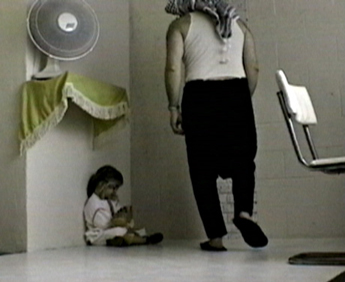Exquisite Corpse

Video excerpts below. More photos...
About the work
The game of exquisite corpse, invented by the French surrealists in the 1920s, has a group of collaborators add their contribution to a work in progress in sequence, sometimes knowing only a small fraction of the context of the work. A game of Exquisite Corpse to pass the time in a hotel basement during an air raid leads to seven tales loosely based on S. Ansky’s play “The Dybbuk,” set in the year 2020 against the backdrop of a toxic cleanup in Haifa, Israel. The tales are: The Gem Cutter's Tale. The Widow's Tale. The Camera's Tale. The Widow's Son's Tale. The Neighbors' Tale. Lila's Tale. The Mosaic's Tale.
Video
The Camera's Tale + The Widow's Son's Tale. The widow takes her son to the beach
for his tenth birthday.
The Neighbors' Tale + Lila's Tale. Lila (played by Mary Ajideh) returns to Haifa.
The neighbors notice something strange.
Credits
- Performers: Lila Elias, Bassem Elias, Galen Al-Askari, Elaine El-Askari, Lev El-Askari, Mary Ajideh, Max Kitaj
Josepha Fath, Elisabeth Benjamin, Jerry Carniglia, Kate Donahue, Gwen Harper, Lisa Kaborycha, Elena Mount, Marianne Macdonald Tomita, Toyoji Tomita, Greg Harper, Bob Hughes, Margaret Fisher - Music by: Robert Hughes, Ludwig van Beethoven.
- Voice-over: Bassem Elias, Yishai Hope, Hava Ratinsky.
- Produced by: Second Evening Art and MAFISHCO
- Written, Directed, Edited by: Margaret Fisher
- Full credits: see, The Mosaic's Tale, Excerpt 8.
- Languages: Arabic, Hebrew, English. Subtitles: English.
- Release date: 2006. Genres: Faux Foreign, Experimental Video. TRT: 27 minutes.
The Seven Tales
The Gem Cutter's Tale. A Palestinian Israeli gem cutter and widower, lives with Lila, his three-year old daughter. The U.N. Toxic cleanup beneath his window creates too many vibrations to allow him to cut diamonds. Seeking distraction, the gem cutter suggests a game to Lila. They will chart the road to her mother in Paradise. Lila rules that the winner of the game must always win; and the winner will pave the road to Paradise with mosaics. Outside, an ancient mosaic is discovered under the toxic soil. It shows a tree growing out of the legs of an antelope. When the cleanup is extended indefinitely to determine what to do with the mosaic, the gem cutter takes his daughter to Beirut.
The Widow's Tale. A Russian widow gives birth to a boy just after arriving in Haifa as a new immigrant to Israel. With the help of a nurse from Social Services, she rents the gem cutter's vacant lodgings but soon has misgivings. The gem cutter's gift of a mezuzah breaks. She is unable to read the Arabic signs in the window and the toxic cleanup outside resumes. She dreams that the large windows break and she cannot save her son.
The Camera's Tale. A home movie of the widow's son celebrating his tenth birthday captures his joy as he cavorts in the water with his dogs. A radio at the water's edge is tuned to a call-in program that discusses the national controversy over a performance of Beethoven's Ninth Symphony in Haifa. The boy's joy and Beethoven's Ode to Joy take a surprising turn.
The Widow's Son's Tale. The ten-year old boy sends his mother a letter from Paradise.
The Neighbors' Tale. With the death of her boy, the widow leaves Haifa and the gem cutter and his daughter re-occupy their former lodgings. The Neighbors, concerned about Lila's behavior and appearance, have diverse opinions about her condition. One suspects the boy's dybbuk or soul has entered Lila. Lila becomes obsessed with Hebrew. She attaches payas, the long sideburns of Hassidic Jews, to her eyeglasses and insists she will marry a Jewish boy.
Lila's Tale. As a young woman, Lila's tale is one of impatience and frustration. She calls the local radio host to voice opposition to the salvage operation of the mosaic found under her window when she was a child. The mosaic is toxic but some people want it displayed because of its unique historic perspective on two diverse and warring peoples.
The Mosaic's Tale. The mosaic, dating to Late Byzantium and Early Islam, records the victory of one people over another. A U.N. Special Council holds a hearing to determine its future. Discussion vacillates between the risks inherent in its preservation and the actual threat presented by the toxins. The solution best suited to restoring the mosaic to its pristine state is a political act of enormous consequence to the region.